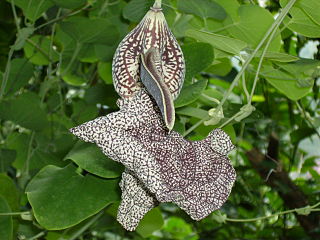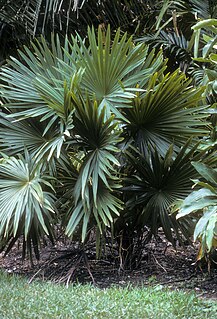
Aristolochia is a large plant genus with over 500 species that is the type genus of the family Aristolochiaceae. Its members are commonly known as birthwort, pipevine or Dutchman's pipe and are widespread and occur in the most diverse climates. Some species, like A. utriformis and A. westlandii, are threatened with extinction.

Chuniophoenix hainanensis, also known as Hainan fan palm, is a species of palm tree. It is endemic to China.

The Hainan gymnure or Hainan moonrat is a species of mammal in the family Erinaceidae. Its natural habitat is subtropical or tropical dry forests. It was thought to be endemic to the island of Hainan, China where it is threatened due to habitat loss, but in 2018 was found to also occur in, and be rather common, within Northern Vietnam.
Alphonsea hainanensis is a species of plant in the Annonaceae family. It has been recorded from Vietnam and China.
Aristolochia cucurbitifolia is a species of plant in the family Aristolochiaceae. It is endemic to Taiwan.
Aristolochia cucurbitoides is a species of plant in the family Aristolochiaceae. It is endemic to China.
Aristolochia delavayi is a species of flowering plant in the family Aristolochiaceae. It is endemic to China.
Aristolochia obliqua is a species of plant in the family Aristolochiaceae. It is endemic to China.
Aristolochia scytophylla is a species of flowering plant in the family Aristolochiaceae. It is endemic to China.
Aristolochia thwaitesii is a species of plant in the family Aristolochiaceae. It is endemic to China.
Aristolochia tuberosa is a species of plant in the family Aristolochiaceae. It is endemic to China.
Aristolochia utriformis is a species of plant in the family Aristolochiaceae. It is endemic to China. It is found in forests at about 1900 meters in Yunnan Province. The plants are climbing herbs or shrubs that have pointed leaves with heart shaped bases. The yellow-green flowers are tube shaped and bent. They hang from the base of a leaf.

Aristolochia westlandii is a species of plant in the family Aristolochiaceae. It is found in China and Hong Kong, in valley forests in Guangdong Province at an elevation of 300 to 800 metres. The leaves are long, narrow and pointed. The flowers are bent tubes from 10–15 centimetres (3.9–5.9 in) long that grow from the base of a leaf. They are yellow with purple veins and blotches.
Aristolochia yunnanensis is a species of plant in the family Aristolochiaceae. It is endemic to China.
Begonia hainanensis is a species of plant in the family Begoniaceae. It is endemic to China.
Gmelina hainanensis is a species of tree in the family Lamiaceae. It is a medium-sized tree, up to 15 metres (49 ft) tall, growing on open grassy hillsides and sparse forests. It is found in southern China and in Vietnam.
Paranephelium hainanensis is a species of plant in the family Sapindaceae. It is endemic to China. It is threatened by habitat loss.
Richella hainanensis is a species of plant in the Annonaceae family. It is endemic to China.
Sonneratia hainanensis, the Hainan sonneratia, is a species of plant in the family Lythraceae.
Stenochlaena hainanensis is a species of fern in the family Blechnaceae. It is endemic to China. Its natural habitat is subtropical or tropical dry forests. It is threatened by habitat loss.




